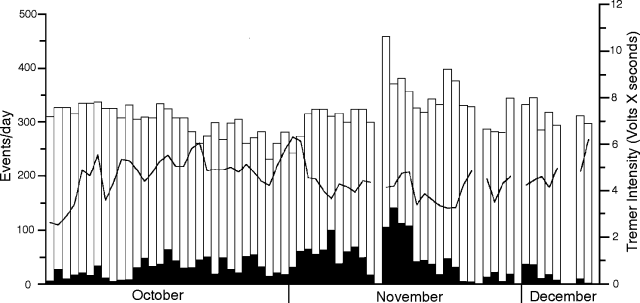Report on Stromboli (Italy) — January 1995
Bulletin of the Global Volcanism Network, vol. 20, no. 1 (January 1995)
Managing Editor: Richard Wunderman.
Stromboli (Italy) Seismicity low and stable in late 1994
Please cite this report as:
Global Volcanism Program, 1995. Report on Stromboli (Italy) (Wunderman, R., ed.). Bulletin of the Global Volcanism Network, 20:1. Smithsonian Institution. https://doi.org/10.5479/si.GVP.BGVN199501-211040
Stromboli
Italy
38.789°N, 15.213°E; summit elev. 924 m
All times are local (unless otherwise noted)
After the decrease in tremor intensity that characterized the first half of September, seismic activity generally remained stable from the end of September to mid-December (figure 38). Tremor intensity remained fairly constant, and the number of recorded events was consistently ~300/day. In contrast, the number of major events (ground speed >100 µm/s) started increasing in October and reached a maximum of 141 shocks on 14 November, which represents 38% of the total number of recorded events. This could suggest a greater source depth for the explosions, although visual observations are needed to support this hypothesis. The number of major shocks then decreased to "normal" values during late November and early December.
Geological Summary. Spectacular incandescent nighttime explosions at Stromboli have long attracted visitors to the "Lighthouse of the Mediterranean" in the NE Aeolian Islands. This volcano has lent its name to the frequent mild explosive activity that has characterized its eruptions throughout much of historical time. The small island is the emergent summit of a volcano that grew in two main eruptive cycles, the last of which formed the western portion of the island. The Neostromboli eruptive period took place between about 13,000 and 5,000 years ago. The active summit vents are located at the head of the Sciara del Fuoco, a prominent scarp that formed about 5,000 years ago due to a series of slope failures which extends to below sea level. The modern volcano has been constructed within this scarp, which funnels pyroclastic ejecta and lava flows to the NW. Essentially continuous mild Strombolian explosions, sometimes accompanied by lava flows, have been recorded for more than a millennium.
Information Contacts: R. Carniel, Univ di Udine.


